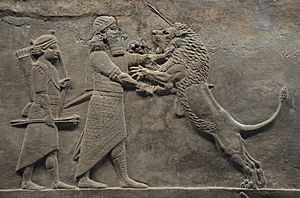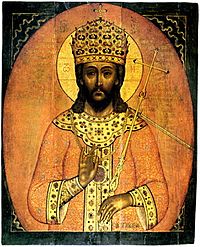King of Kings facts for kids
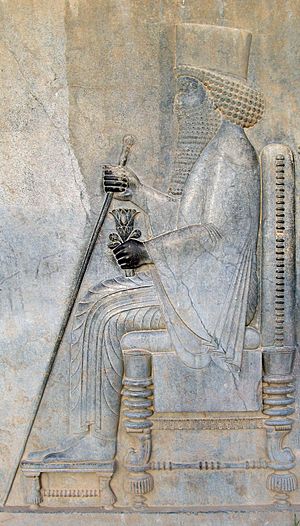
The title King of Kings was a special name for powerful rulers, mostly from the Middle East. It's like saying "the boss of all bosses" among kings! This title is most famous for kings in Iran (also known as Persia), especially during the Achaemenid Empire and Sasanian Empire.
But the title actually started much earlier in the Middle Assyrian Empire with King Tukulti-Ninurta I around 1233–1197 BC. Over time, many different kingdoms and empires used it. This included Persia, some Greek kingdoms, Armenia, Georgia, and Ethiopia.
People often think of "King of Kings" as being the same as an Emperor. Both titles mean a ruler is more important than a regular king. The last rulers in Iran to use "Shahanshah" (the Persian version), from the Pahlavi dynasty (1925–1979), also saw it as meaning "Emperor." In Ethiopia, their title Nəgusä Nägäst also meant "King of Kings" and was officially translated as "Emperor."
Sometimes, there were female versions of the title. For example, Empress Zewditu of Ethiopia was called "Queen of Kings." In the Sasanian Empire, a queen might be called "Queen of Queens."
In Judaism, "King of Kings of Kings" is a name for God. In Christianity, "King of Kings" is used to describe Jesus Christ in the Bible. However, in Islam, the title "King of Kings" or "Shahanshah" is generally not approved.
Contents
History of the King of Kings Title
Early Use in Ancient India
In Ancient India, rulers used words like Chakravarti or Mahārājadhirāja to mean "King of Kings." These terms show up in old texts like the Rigveda, which dates back to 1700 BC.
King of Kings in Mesopotamia
Assyria and Babylon
The title "King of Kings" (šar šarrāni) first appeared with the Assyrian king Tukulti-Ninurta I. Back then, a šar was just a ruler of a city-state. When the Assyrian Empire grew, its rulers became kings over many of these smaller city-states. So, they were literally "kings of kings."
Later Assyrian kings like Esarhaddon and Ashurbanipal also used this title. The last king of the Neo-Babylonian Empire, Nabonidus, also called himself "King of Kings." Ancient Mesopotamian kings loved to use many grand titles to show their power. For example, Sargon II called himself "Great King," "Mighty King," and "King of the Universe."
Urartu and Media
Kings of Urartu, an ancient kingdom, sometimes used the "King of Kings" title. It's possible that rulers of the Median empire also used it. The Persian version of the title, Xšāyaθiya Xšāyaθiyānām, might have come from the Medes. An old inscription mentions King Sarduri I of Urartu as a "king of kings" who received tribute from other kings.
King of Kings in Iran
Achaemenid Empire Usage
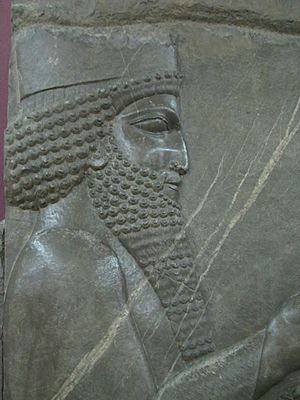
The Achaemenid Empire started in 550 BC and quickly grew very large. It took over many lands, including parts of Asia and Egypt. The Achaemenid kings used a system where they had governors (called satraps) rule different areas. This system was flexible and allowed local rulers some freedom. However, some regions, like Egypt, often tried to rebel.
Every Achaemenid king used the title "King of Kings" (Xšāyaθiya Xšāyaθiyānām). For example, King Darius the Great's full title included "great king, king of kings, king in Persia, king of the countries." King Xerxes I also famously called himself "the great king, the king of kings, the king of the provinces with many tongues."
Parthian and Sasanian Empires
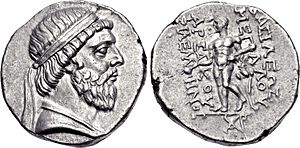
After the Achaemenid Empire, the Parthian Empire rose. King Mithridates I of Parthia was the first Parthian king to use "King of Kings." His nephew, Mithridates II of Parthia, used it often, even putting it on his coins. He wanted to be seen as a successor to the old Achaemenid kings.
The title was called šāhān šāh in Middle Persian. It continued to be used when the Sasanian Empire took over from the Parthians. Ardashir I, the first Sasanian king, called himself "Shahanshah of the Iranians." His son, Shapur I, expanded it to "Shahanshah of the Iranians and non-Iranians" after winning battles against the Roman Empire. This longer title was used by all later Sasanian kings. The last Sasanian Shahanshah was Yazdegerd III. His empire fell to the Rashidun Caliphate in 651 AD.
The female version of the title in the Sasanian Empire was "Queen of Queens."
Buyid Revival of the Title
After the Sasanian Empire fell, Iran was ruled by different Muslim dynasties. Many Iranians were unhappy with the new rulers. The Shi'a Buyid dynasty, which came to power in 934 AD, decided to bring back old Sasanian traditions. They wanted to show their Iranian heritage.
One Buyid ruler, Panāh Khusraw, declared himself Shahanshah in 978 AD. He did this after uniting all the Buyid lands. Other Buyid rulers who controlled the whole empire also used this title. Sometimes, using the title caused arguments, as some religious leaders thought it was wrong. But eventually, a group of scholars agreed that it was allowed.
Hellenic Usage
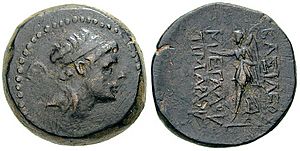
When Alexander the Great conquered the Achaemenid Empire, his empire later split. The Seleucid dynasty inherited many of the former Persian lands. While Alexander didn't use Persian titles, later Seleucid kings started to. Their main title was "Great King," similar to "King of Kings."
Later, even when the Seleucid Empire was smaller, the title "King of Kings" was used again. Some rulers outside the Seleucid Empire, like in Pontus, also took this title. It might have meant that the ruler was supreme, but not necessarily that all other kings were their direct servants.
Armenia
After the Parthian Empire defeated Armenia in 105 BC, the Armenian prince Tigranes the Great was held hostage. He later became king and built a powerful empire. After conquering Syria in 83 BC, Tigranes called himself "King of Kings." Later Armenian kings of the Bagratuni dynasty also used this title, calling it Shahanshah like the Persians.
Georgia
The title "King of Kings" was also used in the Kingdom of Georgia. King David IV (1089–1125 AD) brought it back, calling it mepet mepe in Georgian. All Georgian monarchs after him, like Tamar the Great, used it to show their rule over all Georgian lands and smaller kingdoms. This title likely came from the ancient Persian one.
Palmyra
After a victory against the Sasanian Empire in 262 AD, Odaenathus, the ruler of Palmyra, created the Palmyrene kingdom. Even though he was a Roman ally, Odaenathus took the title "King of Kings." His son also used it. They might have used it to show they were successors to the Greek Seleucid Empire, which once ruled the same areas. However, Odaenathus's second son and his mother soon switched to Roman titles like "Emperor" and "Empress."
Ethiopia
The title "King of Kings" (Nəgusä Nägäst) was used by rulers of the Kingdom of Aksum as early as 250 AD. Later, the rulers of the Ethiopian Empire (1270–1974 AD) also used it. It was often translated as "King of Kings" or officially as "Emperor." For most of Ethiopia's history, there were regional lords who were "kings" under the "King of Kings." Even when this practice ended, Emperor Haile Selassie still kept the title. Empress Zewditu, the only female ruler of Ethiopia, used the title "Queen of Kings."
Champa
From the 7th to the 15th century, the rulers of Champa (in modern-day Central Vietnam) used titles like maharajadhiraja (great king of kings) and pu po tana raya (king of kings).
King of Kings in Religion
Judaism
In Judaism, the phrase "King of Kings of Kings" (Melech Malchei HaMelachim) became a name for God. The extra "of Kings" was added to show that God is even higher than the powerful Babylonian and Persian kings mentioned in the Bible.
Christianity
The title "King of Kings" is used to describe Jesus Christ several times in the Bible. For example, in the First Epistle to Timothy and the Book of Revelation, it says:
- "...He who is the blessed and only Sovereign, the King of kings and Lord of lords..." (First Epistle to Timothy 6:15)
- "...He is Lord of lords and King of kings..." (Book of Revelation 17:14)
- "...on His robe and on His thigh He has a name written, 'KING OF KINGS, AND LORD OF LORDS.'" (Book of Revelation 19:16)
Some Christian kingdoms, like Georgia, Armenia, and Ethiopia, used this title for their rulers. The Byzantine Emperors also used a similar phrase, meaning "King of Kings, ruling over those who rule." They saw "King of Kings" as meaning "Emperor of Emperors."
Islam
After the Sasanian Empire fell in 651 AD, the title Shahanshah was criticized in the Muslim world. Some Islamic scholars believed that only God should be called "King of Kings." This idea is found in some Islamic texts called hadith. For example, one hadith says:
- "Allah's Apostle said, 'The most awful name in Allah's sight... will be (that of) a man calling himself Malik Al-Amlak (the king of kings).'"
This shows that using "King of Kings" was seen as disrespectful because it suggested a human ruler had power that only God should have.
Modern Use of King of Kings
Iran
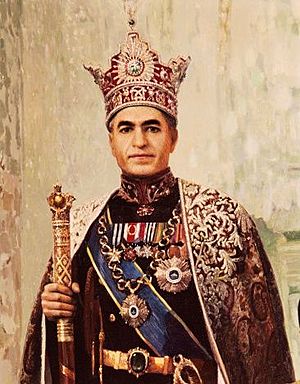
After the Buyid dynasty ended in 1062, the title Shahanshah was used on and off by Iranian rulers. It appeared on some coins of Alp Arslan, a sultan of the Seljuk Empire.
Ismail I, who founded the Safavid dynasty, called himself Shahanshah of Iran in 1501. The title was also used during the Timurid Empire and by Nader Shah of the Afsharid dynasty.
Fath-Ali Shah Qajar (1797–1834) of the Qajar dynasty also used the title Shahanshah. His reign was known for its grand ceremonies.
The last two rulers of the Pahlavi dynasty, Reza Shah Pahlavi and Mohammad Reza Pahlavi, also used the title Shahanshah. Mohammad Reza Pahlavi officially took the title in a big ceremony in 1967. He said he waited because he felt he "did not deserve it" until Iran became a stronger country. After he was overthrown in 1979, his son, Reza Pahlavi II, symbolically declared himself Shahanshah in 1980.
Libya
In 2008, the Libyan leader Muammar Gaddafi was given the title "King of Kings." More than 200 African tribal kings and chiefs supported his use of the title. They called him "the king of kings, sultans, princes, sheikhs and mayors of Africa." At a meeting in Benghazi, Gaddafi received gifts like a throne and urged the chiefs to push for a united African continent with one army, currency, and passport.
See also
 In Spanish: Sahansah para niños
In Spanish: Sahansah para niños


